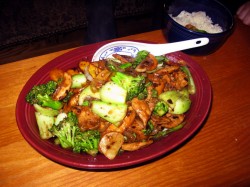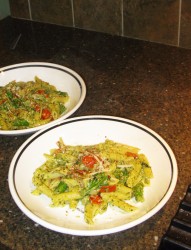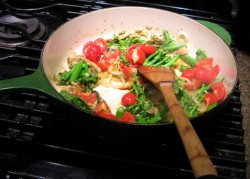It’s The End of an Era…
No, I am not talking about the death of Michael Jackson. Nor am I opining upon the resignation of Sarah Palin.
Nope.
This is about the death of a kitchen tool that has been a part of my life for well over ten years, which I found out about from an ad in the back of an old issue of Fine Cooking Magazine. It has served me well in my own kitchen as well as in the kitchens of others, and I even used it a bit when I worked in a professional kitchen–I just packed the critter up and carted it off with me.
Yes, my Sumeet has suffered a most final, and decisive death.
It is a sad, sad day.
It has been limping along for months–the motor housing cracked a long time ago, and was repaired with duct tape. The blades had finally dulled to the point that I could no longer put peeled chunks of ginger into the container and have them grind up–I had to roughly chop it first, and then the Sumeet would grind it to a paste. Fresh coconut and even worse, galangal had become impossible, even if cut into small pieces. And channa dalia–well, that is what put the final nail in the coffin of my faithful kitchen friend and burned out its workhorse motor. (The smell of burning motor bits is distinctive, disturbing and quite final. It was the smell, in addition to the sound of interior motor bits grinding against each other that told me that the Sumeet had given up the ghost.)
So, I raise my (third) cup of coffee of the day to my old friend and boon companion in all endeavors culinary, and wish it Godspeed as it goes off on its last adventure.
I feel as if I should give it a Viking burial, complete with grave offerings and burning ship, but I suspect I would get cited for littering, pollution of a waterway and unauthorized burning of a kitchen appliance in public if I hiked myself down to the Hocking River and after arranging a full array of funerary offerings (heaps of spices, garlic and ginger, most likely) around it on a raft, I set the supine Sumeet ablaze with all proper pomp and grief-filled circumstance.
So, let this post stand as the funeral to my loyal helpmate who until this very hour on this very day, never let me down, no matter what manner of crazy ingredients I set it to grinding.
Needless to say, I immediately ordered a replacement, but after doing research all over the web, but particularly among Indian blogs and websites, and hearing from readers of my blog over months that the company that makes Sumeet has given up on customer service, and reading reviews of other Indian wet-dry grinders, I decided to pick up a Preethi. (I started this research months ago, as I knew that this day was coming. The Sumeet has been wheezing along pathetically for a long time, so I have been preparing for its eventual demise.)
I have read great reviews of Preethi’s various wet-dry grinders and it looks and sounds like it will be a worthy successor to my old and dear kitchen friend.
Look for a review of my new kitchen goodie when it arrives.
Until then, I will be back to grinding spices the old fashioned way–with a mortar and pestle. (The good thing about the old ways is that they always work, they don’t require electricity and the stone implements required do not wear out within a human lifetime.)
Black Bean Chicken With Mixed Vegetables
As if to prove to my avid omnivorous readers that I am not going to start writing exclusively about vegetarianism and presenting only vegetarian recipes, here is a quick and delicious, if non-traditional Chinese stir-fry that makes a great summer dinner that keeps the house reasonably cool, and makes a nutritious meal that is full of color, flavor and contrasting texture.
Most traditional Chinese homestyle stir-fried dishes did not combine a meat with a whole passel of mixed vegetables–usually if meat and vegetables were combined in a single dish it was one meat and one vegetable, or meat with a pair of vegetables. The vegetable melange you see mixed with meat in modern Chinese stir-fries arose from Chinese American restaurants, where customers were not accustomed to the idea of ordering separate meat and vegetable dishes.
I had intended to make Chicken with Broccoli-a mainstay of the Chinese-American restaurant menu: a dish consisting of exactly what its name tells you, plus a more-or-less ubiquitous savory brown sauce. However, I ended up cooking for two more people than I expected, and I had no extra chicken or broccoli, so I dug through my crisper drawer, and pulled out tender local bok choy and sweetly crisp local carrots.
So, my Chicken with Broccoli was instantly transformed into Chicken with Mixed Vegetables.
As for the black bean–while I like Chicken and Broccoli, that brown sauce, savory as it might be is a little flat to my taste, even when it is a particularly flavorful version of it. Made primarily of chicken broth or stock, soy sauce and a drizzle of sesame oil, with a dash of rice wine, it is a good sauce. (When made well. When made badly it is a sickly-sweet brown gloppy mess.) But I like my Chinese sauces to have a little more bang for the buck–I like little explosions of flavor on my tongue.
And for that, I turn to Chinese fermented, salted black beans. Black soybeans that have been salted and fermented, these little fellows pack a serious umami punch and they make everything taste just so much better. Paired with plenty of fresh garlic, they create a cloud of deliciousness that surrounds and pillows the main ingredients in your stir-fry, bathing them in savory goodness. If you add a teaspoon of chili garlic paste and a couple of teaspoons of ground bean sauce as I did, the usual restaurant brown sauce is kicked up so many notches it just flies into orbit and takes your taste buds with it.
You could substitute pressed spiced tofu for the chicken, or you could use pork instead. You could also substitute any number of vegetables for the combination that I put together out of my fridge–you could use gai lan instead of broccoli, and choy sum instead of bok choy with sweet red peppers instead of carrots. Or, how about mushrooms, water chestnuts and sweet red peppers? Or green beans, carrots, and sweet red peppers?
Really, any combination of vegetables would be tasty in this dish, I think, so long as they are vegetables that are suitable for a stir-fry.
At any rate–here we are–a meat dish, but one that uses a plethora of summer vegetables. Something to please everyone.
Black Bean Chicken with Mixed Vegetables
Ingredients:
1 chicken breast, boned, skinned and cut into 1″X1/2″X1/4″ strips
2 tablespoons light soy sauce
1 tablespoon Shao Hsing wine
2 tablespoons cornstarch
3 tablespoons canola or peanut oil
1 large onion, peeled and sliced thinly
1 1/2 tablespoons fermented black beans
1/2-1 teaspoon chili garlic paste
1″ chunk fresh ginger, peeled and thinly sliced
3 cloves garlic, peeled and thinly sliced
1/4 cup Shao Hsing wine
2 tablespoons light soy sauce
1/2 cup peeled and thinly sliced on the bias carrots
2 cups broccoli florets–cut into bite sized pieces
1/3 cup chicken broth
1 cup bok choy cut into 1″ chunks
2 teaspoons ground bean sauce
1/2 teaspoon toasted sesame oil
Method:
Toss chicken pieces with the first measure of light soy sauce, Shao Hsing wine and cornstarch and allow to sit for at least fifteen minutes, but no longer than a half hour or so.
Heat wok over high heat until a thin ribbon of smoke coils upward from the surface. Add canola or peanut oil and heat until the oil shimmers–about thirty to forty-five seconds.
Add onions and black beans, chili garlic paste, and cook, stirring constantly until the onions turn translucent and golden. Add ginger and cook for another thirty seconds, stirring.
Add chicken to wok, and spread into a single layer of the bottom of the wok. Sprinkle with the garlic slices, and allow chicken to cook, undisturbed, for about a minute or a minute and a half–until the chicken browns on the bottom. Then, stir and cook, stirring constantly until about 1/2 of the chicken is white or brown and the rest is still pin. Sprinkle with the second measure of wine and stir, scraping the browned bits of marinade off the wok, deglazing with the wine. Add the soy sauce and carrots and cook, stirring until the chicken shows very little pink.
Add the broccoli and cook, stirring, until it deepens in color and the chicken shows no pink. Add the chicken broth, and the bok choy and cook, stirring and scraping any browned bits off the side of the wok into the sauce. Spoon in the ground bean sauce and stir to combine.
Remove from heat and drizzle with toasted sesame oil and stir well to combine. Scrape into a warmed serving platter and serve immediately with steamed rice.
Making Mondays Meatless
I know that the Meatless Monday campaign promoted by Johns Hopkins Bloomberg School of Public Health has been in the media a lot recently, but I still wanted to present it to my readers because not only is it a good idea for our personal health to eat less meat, it is good for our environment as well. And–eating meatless one day a week helps us come up with even more delicious ways to use up the abundant local produce that is filling our farmers’ markets this summer.
Promoted by none other than author Michael Pollan (The Omnivore’s Dilemma) as well as many other celebrities, institutions, restaurants and countries (yes, I said countries) the concept of Meatless Monday is simple–one day a week, pledge to eat no meat. That’s it.
Simple.
Now, you can go farther and go vegan once a week, but that isn’t necessary. Or, you can eat vegetarian more than one day a week. I suspect that a lot of people will end up eating no meat more than one day a week once they realize how tasty vegetarian food really is–personally, this summer I have been eating meatless about three days a week. (You may have noticed that most of the last twenty recipes or so on this blog have been vegetarian. There is a reason for that–not only are we eating less meat here at Chez Barbara, but I am committed personally to showcasing delicious vegetarian recipes more often than I have in the past.)
Basically, while I am still an omnivore, and a committed locavore, I also want to eat less meat–even if the only meat we eat in this household is locally produced and grass fed– because eating a little lower on the food chain a little more often is good for our health and helps save a tremendous amount of carbon emissions. (On Oprah’s Earth Day special, Michael Pollan noted that if every household in America went meatless one day a week, it would be the equivalent of removing 20 million mid-sized sedans from the road.)
Meatless Monday isn’t just a modern liberal/progressive/vegetarian plan to save the animals and the environment–it has a venerable history in the United States. During both World War I and World War II, there were calls to eat less meat in order to support the war effort, and Meatless Monday was one of the programs instituted by the Federal Government to help succeed at the goal of not only feeding the army, but the starving populations of Europe whose own crops had been destroyed by war.
It was a good idea then, and I think it is a good idea now–and it is an idea that is beyond political ideology or identity. Research has shown that eating less meat is good for -everyone- and that means everyone no matter what their political beliefs.
Now, I am not advocating that everyone go vegetarian or vegan here. I am not being radical about this–I am just suggesting that we eat more plant-based foods than most Americans do, and the idea of setting aside one day a week to be completely meatless is an easy, relatively painless way to go about it.
So, in support of Meatless Monday, I will begin every week with a new vegetarian recipe that will make a great supper, guaranteed to taste good to vegetarians and omnivores alike. And, in support of Meatless Monday, I will evangelize the movement by serving guests–especially those who think they don’t like vegetarian food–amazingly delicious vegetarian meals.
This Saturday, I started my evangelical movement in support of meatless, locally sourced meals by feeding my Mom and Dad, both of whom are very “meat and potato” oriented sorts of folks, a meal that consisted of my Eggplant, Walnut and Tomato Bruschetta and New Potatoes with Pesto and Cherry Tomatoes.
What was the reaction?
They both loved it. They loved the sauces (Melanzane Con Noci and Pesto) so much that Mom asked for the recipe, and Dad praised them both vociferously. (Even better–they had come to visit Saturday morning, all the way from West Virginia, to shop at the Athens Farmers’ Market!)
Even my parents are eating more meatless meals–in fact, for his birthday dinner, Dad asked Mom to make him Eggplant Parmesan–and this is from the man who once disliked eggplant. (I am pleased to have been instrumental in removing his eggplant-phobia by presenting him with a Portuguese eggplant appetizer I had learned to cook in culinary school when I visited home during break.)
Look, here is the deal–if my parents can do it–so can you, me and everyone else.
So, get on board and go meatless, if not this Monday, then next.
And if you need some recipes to get you started, check out my recipe category, Almost Vegetarian, Vegetarian and Vegan.
Or take a look at these recipes hand picked by me for you to try today:
Palak Dal, South Indian Style
Linguine With Olives, Feta and Lemon
Imam Bayildi
Heather’s Pasta With Mushrooms and Peas
Kashmiri Dhingri Chole
Chinese Noodles With Mushroom-Tofu Sauce
Or check out the recipes at A Veggie Venture and Fat Free Vegan Kitchen for inspiration.
Leftover Makeover: From Pasta Sauce to Bruschetta
Bruschetta is a lovely way to use up leftovers. Consisting of sliced bread rubbed with garlic and brushed with olive oil then topped with any number of toppings and grilled or toasted, bruschetta is usually served as an appetizer or snack, but I think it can make a nice light lunch, especially if served beside a crisp green salad.
A perfect way to use up day old bread, bruschetta is an already frugal dish; but when you use leftovers as toppings, it is doubly frugal.
What sort of leftovers do I have in mind?
Well, I had made a batch of Melanzane con Noci–a Sicilian pasta sauce made with roasted eggplant, garlic and toasted walnuts which is traditionally served over spaghetti–but had more sauce than two people could eat. While I could have simply frozen the leftover sauce, I wanted to figure out another way to use this delectable puree.
In putting together the bruschetta, which I made for Brittney and I for lunch, I decided to forgo rubbing the bread with garlic as the sauce is already quite sufficiently imbued with garlic; instead, I simply brushed 1/2 inch thick slices of multi-grain baguette (cut on the diagonal) on both sides with extra-virgin olive oil. Then, I spread about a tablespoon and a half of the cold pasta sauce on top of the bread. This was topped with a sprinkling of fresh basil leaves cut in a chiffonade, then on top of that, thinly sliced tomatoes and a generous, heaping teaspoon of freshly shredded Parmesan cheese.
Then all that is left to do was to place the slices on a tray and pop them under the broiler for a few minutes–until Parmesan is bubbly and melted and the bread is toasted and crisped.
That is all there is to it–and frankly, as much as I love Melanzane con Noci as a pasta sauce–I liked it even better as a bruschetta topping. The rich sauce –a thick puree, garlicky and filled with the flavor of roasted eggplant and nuggets of toasted walnuts–tasted amazing on the crisped bread, and combined with the fragrant basil, tangy fresh tomatoes and salty cheese–it was a delicious contrast of flavors and textures. And I cannot imagine anyone not liking it–even folks who swear they dislike eggplant. It is also the sort of vegetarian dish that could convert the most ardent of meat-eaters!
Which made me think that there must be plenty of other pasta sauces that could be used to top bruschetta.
Have any of you used your leftover pasta sauces in such a way? Or have you done something else with them?
Pesto: A Kat’s Favorite Dish
In the summer, I make pesto at least once or twice a week, and have been doing so for the last five or six years. I always plant an abundance of basil in the garden and then harvest it all summer long, enough to make a meal or two’s worth of pesto each week–so for years, Zak and I have been eating copious amounts of this delicious garlic and basil based sauce.
And what is cool is this–Kat loves it. She will eat pasta and chicken in shocking amounts, so long as it is slathered in pesto. So far, I cannot convince her that vegetables are good with anything–the tomatoes she loved for her first two years of life have turned into anathema, and she will nothing else that is green BUT basil or pesto, but I don’t let that stop me from adding any number of seasonal vegetables to the dish: sweet snap peas, french filet beans, onions, mushrooms of any sort, tomatoes, baby zucchini, and my new favorite combination–broccoli rabe and cherry tomatoes.
But no matter what vegetables I add, Kat avoids them–she just eats around them to get to the penne pasta and sauteed chicken slivers. (Just now, I convinced her to eat a carrot. And she did–amazing.) Now she eats both the pasta and chicken in amazing quantities for such a small person, so I guess that is something.
I realized when I posted about the new potatoes with pesto a couple of days ago that I had never really given my recipe for pesto. It isn’t really anything special, and I had never really written in down because I never really measured the amounts of the ingredients–I always just made it by eye and to taste.
And that is probably the best way to make pesto–to your own taste. You have to take into account the different strengths of flavor in each of the major ingredients: every garlic clove is not the same. Garlic varies widely depending on variety, freshness and where and how it was grown. Some of it is quite mild, some is hot and spicy and some is sweet.
Basil is similarly variable—depending once again on variety, where and how it was grown and how fresh it is. I like using a combination of Genovese–which is a pretty standard Italian broad-leafed variety of basil, and Greek columnar basil–which has smaller leaves and grows in a very tall, upright habit–which explains the kind of weird name. Genovese has a sweet flavor, which is intensified when grown in a moderately dry environment, while the Greek variety tastes a little bit spicier. Some folks really like Lemon Basil in their pesto, but I prefer it in salad dressings myself.
I tend to use fresh German Extra Hardy garlic in my pesto, which is grown right here in Athens by Rich Tomsu. His garlic is my favorite–it is amazingly strong in flavor, both sweet and spicy. I love the stuff. But when I use it, I don’t need to use as much of it as I would a regular supermarket variety. One or two cloves of it is enough for my basil when it is Rich’s fresh garlic, whereas the stuff from the store would take four of five cloves for the same effect.
Parmesan cheese differs greatly in flavor as well–it depends on how long it was aged, where it was made and how it is sold. Imported Parmesan sold in wedges, blocks or other-sized pieces has a superior flavor and salt content when compared to the shredded or shaved types sold in the dairy case at the grocery store. It is more expensive–but I have discovered that I don’t have to use as much of it as I would otherwise–because it is so strongly flavored. So, it kind of evens out.
Finally, the nuts–I use pine nuts in my pesto exclusively. I love walnuts, but I don’t like them in pesto–they are too strong and dark in flavor–I prefer the sweet, dare I say, “nutty” character of the pine nuts. I also toast them on the stove in a small cast iron skillet, shaking them over a flame until they are golden and fragrant, just before I make the pesto. This brings out their flavor, and adds an extra bit of character to the sauce.
Olive oil is important to the dish–always use the nicest oil you can afford. I like to use Italian or Greek extra virgin olive oil, because they can be peppery and fruity at the same time, as opposed to the Spanish oils which taste kind of grassy. (Which is good for salad dressings, but not so much for my pesto. I have never blended olive oil with another oil, though I have heard of folks slipping some almond or walnut oil into the sauce. I disagree vociferously with this–but to each his or her own. I will stick with the olive oil.
The only other ingredients I use are salt and either freshly ground pepper or Aleppo pepper flakes. I prefer black pepper, but because I sometimes react to it I don’t use it as much anymore. Aleppo pepper is not traditional–but it does give a sweet little burst of heat without tasting out of place in the sauce.
When you have as few ingredients in a sauce as we do with pesto–it behooves us to get the best we can afford and use them judiciously. I prefer home-grown basil, fresh, strong garlic, good peppery olive oil, imported cheese and toasted pine nuts–with a bit of kosher salt and Aleppo pepper in mine. Others may do it differently–remember this is a sauce to be made to taste. Some folks don’t like super-strong garlicky pesto–but I do. Some prefer the basil to stand out and leave the garlic in the background–I like them both to be up front and in your face. I like a deep green sauce that keeps your tongue dancing and your senses reeling.
Otherwise, its no fun.
And apparently, Kat agrees with me–just this evening, she asked if we could have pesto again, “Tomorrow?”
Tomorrow it is.
Pesto
Ingredients:
2-3 cups fresh basil leaves
2-5 cloves garlic–this depends on how garlicky your garlic is
1/2 cup toasted pine nuts–you can leave these out if you want, but I like them included–I don’t like walnuts, though
1/2-3/4 cup shredded Parmesan cheese
1/3-1/2 cup really good extra virgin olive oil–I tend to use less olive oil than other folks do
1/4 teaspoon Aleppo pepper flakes or freshly ground black pepper
salt to taste
Method:
Grind everything up in a food processor until a thick, green paste is formed.
What can you do with pesto?
You can obviously use it to dress pasta. Lots of vegetables can go with the pasta. Chicken is good with it. You can use it to top broiled or grilled salmon. Imagine cooking salmon with some tomato slices on top, and then spreading some freshly made pesto on top just before service.
You can toss it with baby new potatoes and cherry tomatoes. You can use it to flavor cream soups–it makes kick ass cream of potato soup. I bet it would be equally good with broccoli soup.
You can probably use it in mashed potatoes, too, so long as you didn’t mind that they were green!
Powered by WordPress. Graphics by Zak Kramer.
Design update by Daniel Trout.
Entries and comments feeds.












